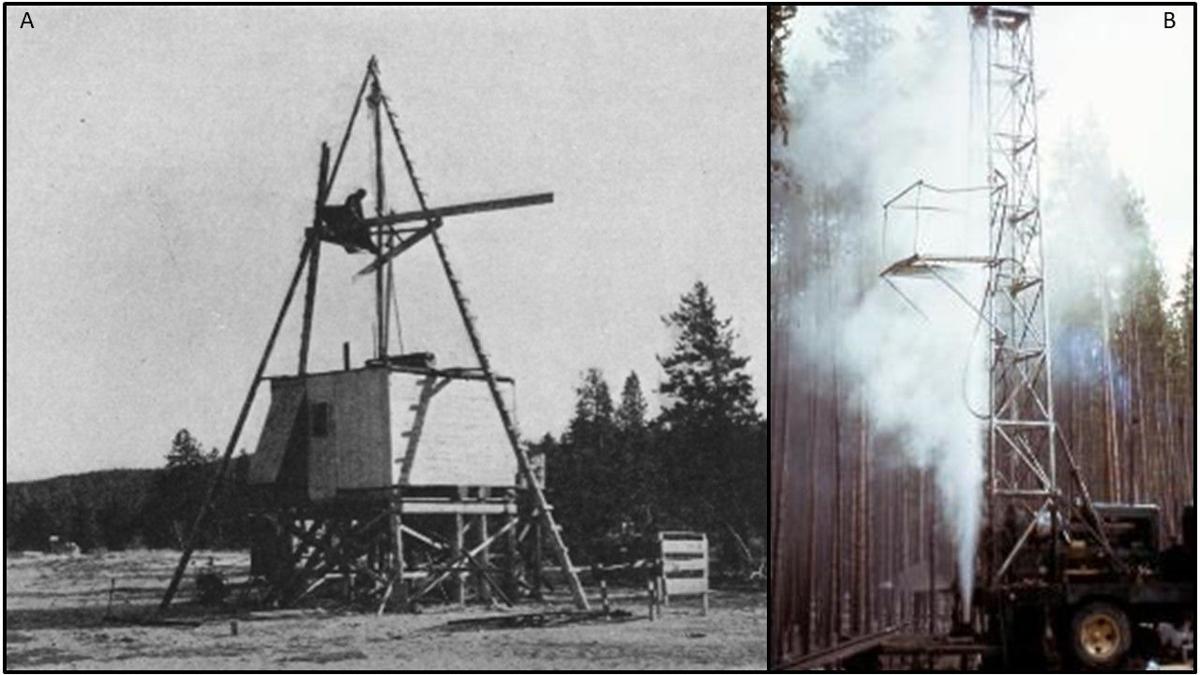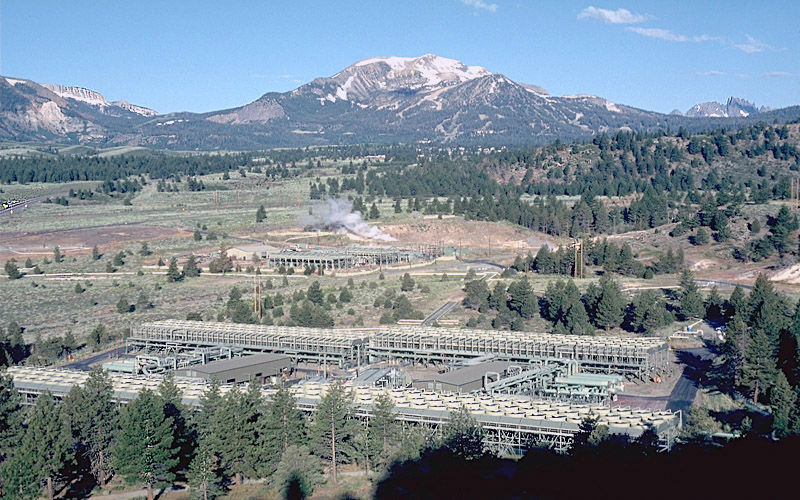Caldera chronicles: Why drilling the Yellowstone volcano to stop eruptions or generate power is a bad idea
Dec 24, 2021

Research drilling in Yellowstone National Park. (A) is an image from Fenner (1936) of the drilling setup in the Upper Geyser Basin during the 1929 field season. (B) is an image from White et al. (1975) of the USGS drill rig set up in the Norris Geyser Basin in 1967-68 during a steam eruption.
Courtesy photos

Mammoth Mountain, on the edge of Long Valley caldera (California), is the dominant peak on the skyline, and the jagged peaks to the right of Mammoth Mountain are the Minarets. The Casa Diablo Hot springs are just beyond the power facility along the western edge of a down-faulted block at the southwestern margin of the caldera’s resurgent dome. The low ridge in the middle right of the photo marks the western edge of the down-faulted block.
Yellowstone Caldera Chronicles is a weekly column written by scientists and collaborators of the Yellowstone Volcano Observatory. This week's contribution is from Michael Poland, geophysicist with the U.S. Geological Survey and scientist-in-charge of the Yellowstone Volcano Observatory.
It’s a common question – why not just drill into Yellowstone to relieve the pressure? And it seems like a reasonable idea given the way that magma chambers are often depicted: as caverns of expanding liquid magma that just need to be tapped, like letting air out of a balloon.
Magma reservoirs are much more complex than this simple depiction, however. Instead of huge balls of liquid magma, they are a mushy mix of rock, melt, crystals and various fluids and gases, with poor interconnectivity and often no sharp boundary between the reservoir and the surrounding rock.
Yellowstone provides an excellent example. Seismic imaging techniques (like taking an MRI of the Earth) have revealed two huge magma reservoirs beneath the caldera system: one at 5–17 kilometers (3–10.5 miles) beneath the surface, and a deeper one at 20–50 kilometers (12.5–31 miles). The speed of seismic waves through these reservoirs suggests they are mostly solid – the upper reservoir appears to be only 5-15% molten, and the deeper 2-5% molten.
Pressure within this type of system is not like air in a balloon, and it cannot be easily dissipated by poking a hole, or even a hundred holes, into the complex structure. Within a magmatic system, pressure accumulates because magma and associated fluids are accumulating. It would be as if a balloon were filling with mostly solid cement, with some poorly connected regions that were wet and contained some gases. Poking a hole in that balloon would not cause the cement to disappear, nor would it reach all parts of the poorly connected “wet” part of the system. Moreover, the drill holes intended to tap the gases in a magma reservoir would plug shut with dense taffy-like magma without constant intervention.
But what about cooling the magma reservoir by pumping water into the subsurface? This was the subject of a 2015 report by Jet Propulsion Laboratory engineers, who calculated that the magma chamber could be cooled if a sufficient supply of water were pumped through the subsurface over the course of thousands of years, generating geothermal energy in the process.
While this proposal might seem to make some sense, the calculation overlooked a number of complicating factors. For example, the hotspot fueling volcanism at Yellowstone provides a steady supply of heat. Cooling the magma body by pumping water into the subsurface would be like attempting to cool a pot of boiling water by steadily adding droplets of cold water but leaving the burner on.
For all of these magma quenching and tapping concepts, there is also the issue of unintended consequences. Rapid depressurization and freezing are factors that can drive magma toward the surface by stimulating dissolved gases to come out of solution – like opening a can of soda or putting a can of soda in the freezer (please don’t try this unless you enjoy cleaning up messes!) – so attempts at cooling and depressurizing magma systems might even make an eruption more likely.
But what about power generation, which usually involves drilling into areas often near magma reservoirs and extracting hot water that becomes steam and can be used to drive turbines? Geothermal power is used in many places worldwide – in Iceland, it accounts for about 30% of all power generated in the country.
Geothermal power exploitation in Yellowstone, however, is illegal by act of Congress – the Geothermal Steam Act of 1970 (amended in 1988). This act requires the Department of Interior to preserve and monitor hydrothermal features, like Old Faithful, in units of the National Park Service. There is a good reason the law exists. In many places – including California, Nevada, Chile, New Zealand, and Iceland – geothermal power production has altered the behavior of nearby hydrothermal features. There is still quite a lot we don’t understand about how water moves beneath the surface in the Yellowstone area, and it is likely that even geothermal development outside the park would impact features within the park.
Drilling does have a role to play, however, in better understanding how volcanoes work, including at Yellowstone. In 1929-30, and again in 1967-68, limited drilling was done in some of the geyser basins of the park, to a maximum depth of about 330 meters (1,080 feet), to better understand the shallow hydrothermal system. And in 2007-08, boreholes up to about 250 meters (820 feet) deep were drilled in several locations to host sensitive monitoring instruments. These studies have been invaluable in better understanding how Yellowstone’s hydrothermal and magmatic systems work.
At other volcanoes, drilling has accidentally penetrated active magma bodies. In 2005, drilling in Hawaii encountered magma along the East Rift Zone of Kīlauea Volcano. The hole rapidly closed as liquid magma flowed in and froze. A similar process occurred when magma was unexpectedly encountered during drilling at Krafla volcano, Iceland, in 2009, and in Kenya in 2011. These encounters have motivated a research project – an international magma observatory – that aims to drill into the magma body at Krafla that was encountered in 2009, and to install equipment that will help scientists better understand the conditions in and around magma reservoirs.
Drilling has an important role to play in better understanding and monitoring volcanoes, and in some places it can be a means of generating geothermal power. But as a means of stopping or slowing an eruption, drilling is very unlikely to be helpful. In any case, there is no concern of impending eruptive activity at Yellowstone, so drilling to stop an eruption is an example of a non-solution for a non-problem.
No comments:
Post a Comment